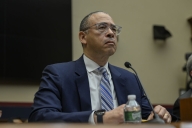You have /5 articles left.
Sign up for a free account or log in.
For college students whose childhoods included one or more major traumas—living with food insecurity or witnessing violence near home, which in the latest Student Voice survey impacted 20 percent and 15 percent of students, respectively—it’s easy to see higher education as a privileged space that doesn’t care about what they’ve endured in life. But when an invitation to share is built into campus life, students are more likely to feel honored and understood.
Take the University of Maryland, Baltimore County, as an example. Students coming to the campus from urban Baltimore, right next door, “wrestle with these issues all the time,” says Delana Gregg, director of academic learning resources, assessment and analysis with UMBC’s Academic Success Center. “It’s part of our curriculum to care about our community and find ways for students’ stories to come into the classroom. We’re actively trying to get these stories.”
A challenge for higher ed during COVID has been maintaining focus amid a continuously evolving public health threat. “At some point with a crisis on campus, you deal with it and then it goes away and then there’s some level of normalcy,” says Fran’Cee Brown-McClure, vice president for student affairs and dean of students at Union College, in New York. “That hasn’t happened since March 2020. It’s been constant crisis with no break.”
Officials at many institutions believe they’re doing pretty well supporting students, especially considering the extra resources invested in various support areas since the pandemic initially shuttered campuses. “Institutions very often think that they are forward-facing, inclusive and supportive, that students really know they understand and care about them,” says Sarah Whitley of NASPA: Student Affairs Administrators in Higher Education. Whitley, assistant vice president for its Center for First Generation Student Success, isn’t so sure students get that impression.
In the Student Voice survey of 2,003 college undergrads from Inside Higher Ed and College Pulse, with support from Kaplan, one in four respondents disagree at least somewhat that their college understands the connections they have to their families and home communities. In addition:
- One-third of students disagree at least somewhat that their colleges are responsive to the needs of all students.
- Nearly one in four disagree at least somewhat that their college makes an effort to understand their current experiences and challenges.
Following are 10 ideas for building stronger connections with students and turning those “disagree” findings around.
1. Educate campus leaders and teams about the range of student traumas.
Significant numbers of Student Voice respondents disclosed having gone through an adverse childhood event, either personally or as a member of their household. Forty-five percent identified depression or other mental health issues, 28 percent experienced emotional abuse and 27 percent dealt with the effects of long-term unemployment, for example.
“It’s a depiction of what our students are navigating,” says Whitley. “They have had hard times.”
Campus mental health services are generally adept at helping students who have dealt with common life events like divorce and death of a grandparent, but they tend to fall short in helping “those from certain neighborhoods likely to get a call that so-and-so got shot,” says Anthony Abraham Jack, an assistant professor at Harvard University’s Graduate School of Education and author of The Privileged Poor: How Elite Colleges Are Failing Disadvantaged Students (Harvard University Press). “The range of traumas in students’ lives go beyond the standard XYZ.” This is especially important, Jack will tell presidents, “as we diversify our campuses with students who come from disadvantaged communities.” Campus teams must understand that someone who has been evicted once has a higher chance of it happening again, and a family that has experienced food insecurity and is one paycheck away from being broke will probably be hungry again, he adds.
2. Ask faculty members to examine syllabi and gradebooks through a racial/equity lens.
Work at the Center for Urban Education at the University of Southern California’s Rossier School of Education has focused on developing open-access tools to engage faculty, student support staff and administrators in understanding how their practices are creating racialized patterns in their educational outcomes, explains Estela Mara Bensimon, founder of the center and a university professor emerita. One tool helps professors gain awareness of how white-centric their syllabus language and course content are. And a gradebook-mapping tool allows professors to notice if, for example, Black and Latinx students tend to wind up with C’s rather than B’s or A’s—and, with the realization that the course isn’t working for students in these groups, to make changes.
“Often faculty may want to do the right thing—they want to perform equally for all their students—but they don’t have the tools to understand why they don’t,” says Bensimon. As the description of the project notes, the issue isn’t to “not be racist,” but rather “whether policies and practices produce racist or antiracist outcomes.”
3. Seek the input of professors, staff and students.
At Wheaton College in Massachusetts, DEAL (diversity, equity and access leadership) is an umbrella entity established in 2018 to create opportunities for innovative diversity work to flourish. Founding member Shaya Gregory Poku, associate vice president for institutional equity and belonging, says there are a lot of aha moments as students, faculty and staff discuss stereotypes and other campus experiences and ultimately come to speak earnestly with and better understand each other. “You have to build all these things before disasters,” Poku says.
Poku will eat lunch with students and attend club events and activities to build relationships with them. “When you’re in their space, it’s different. You have a chance to hear things differently,” she says.
She also tries to engage students in major projects, such as a guide to creating a gender-affirming campus developed with the help of two students. “It was a summer project. They brought new resources, did their own research on articles and added topics they thought we should include,” says Poku.
[block:block=176]
4. Gather institutional data on how much students feel understood.
Having national trend data is a start, but campus leaders can best act on insights about students feeling understood, or not, by conducting their own surveys, says Kristine Goodwin, who recently began a role at Western New England University as vice president of student affairs. She might ask, “Can you name a faculty member, administrator or mentor who sees you, knows you, gets you and encourages you?” And then the idea would be to have students actually name the person. “I’d love to show custodians or dining people that their relationships and their communication with students matters,” she says.
5. Spend time with frustrated students, not just high-performing student leaders.
Just 17 percent of Student Voice respondents agree strongly that their university’s leaders “see” them, while 11 percent disagree strongly. A big reason for the masses not connecting with administrators may be presidents and other top-level officials not seeking out a mix of students to interact with regularly, either in one-on-one conversation or small groups. “We have long-standing relationships with student leaders. For everyone else, it’s come and go,” says Goodwin.
That gives officials limited perspective. “College presidents cherry-pick, and once they have their one or two spokespeople, they ride them until they graduate,” says Jack. “It drowns out the rest of the student body.”
Poku is impressed by one administrative colleague at Wheaton who posts open office hours for any student to drop in. “That’s symbolic, and there’s also substance,” she says, adding that administrators also need to seek out students “who are falling through the cracks, who are most frustrated with the institution, to hear their thoughts and concerns.”
6. Assign students an advocate.
UMBC’s Academic Advocacy model helps connect individual students with one caring person—their assigned academic advocate—who can really get to know that student’s “needs and experiences, and help make the connections with the right resources at the right time,” says Gregg. Even then, the student is not on their own because the advocate can step in as roadblocks appear. Faculty members refer students to the program and an advocate will be assigned to, as they’ll tell students, “help with anything that might get in the way of your academic goals.”
The institution also has first-year academic advocates, dedicated to helping first-time, full-time, degree-seeking undergrads work through academic and institutional challenges.
7. Ensure facilities and dining staff know they’re part of the student support team.
First-generation Student Voice respondents attending private institutions are the most likely group to identify janitorial or other facilities staff, or dining hall workers, as employees who “see” them. But even about one in 10 of the full sample identified these types of employees as part of their “village.”
Brown-McClure from Union will lead an “all-hands-on-deck” meeting with housekeeping and dining teams at the beginning of the year. “I’ll say, ‘You’re a part of this community. If anything ever comes up with a concern for a student, we want you to know where you can go to share that’ … I don’t ask regularly, ‘What do you know or have you heard?’ They’re generally coming to me,” she says.
A report might come in about a particular corridor or even a specific bathroom stall, and during a case management meeting, a counselor could begin sharing information of concern about a student. Suddenly the team realizes that student lives in the exact spot the housekeeping report involved. “We start to put these puzzle pieces together,” says Brown-McClure, noting that she has seen this model with clusters from particular programs work at larger institutions as well.
Conduct-tracking software can even help staff identify something like a student having a pattern of behavior, such as intoxication each year around the same time. “It may come out that this is the anniversary of some traumatic event,” Brown-McClure explains. “It’s about having access to the data and asking questions and saying, ‘There’s something happening here.’”
8. Include disabilities in conversations about diversity.
College students are somewhat evenly split on how much they agree that their colleges are responsive to the needs of all students. Those with learning disabilities are more likely to disagree that student needs are being met.
Elisa Laird, associate executive director for professional development at AHEAD, the Association on Higher Education and Disability, would like to see institutions strengthen relationships with students with disabilities—and “normalize disability as just another aspect of diversity,” she says. Including disability in diversity, equity and inclusion efforts is currently part of the structure at some colleges but not others, Laird adds. But regardless, “everybody could be working together and reaching across campus to create safety nets for all students.”
9. Encourage creative reflection about barriers to success.
UMBC offers a journaling class that helps students process challenges and barriers they’ve encountered. When Gregg has taught the class to those on academic probation (another section is for new students), she introduces it as a safe space to help get them back on track with their goals. Besides the instructor, students get support from an adviser and a financial aid counselor. “I tell students, ‘We are circling the wagons around you this semester, and we can get you completely set up for success,’” she explains.
Journal prompts cover topics such as emotional intelligence, time management and taking personal responsibility. “You can take an active role in taking control, or you can passively let things happen,” she says. “Giving students that ownership over their goals really helps. They feel like they have hope.”
10. Offer tough love where accountability is needed.
Encouraging students to seek help often results in relationship forming and trust building. Poku’s office at Wheaton worked with the film and media studies department on a film featuring students talking to other students about fears related to asking for help, plus the importance of actually doing so, she says. The idea is to create a culture where reaching out for assistance comes naturally.
However, sometimes students need a reminder that requesting help isn’t just about being allowed flexibility and leeway, such as with professors on deadlines. Academic advisers or coaches at Union find themselves having conversations with students who need to shift their approach. “If no one is following up, you think your behavior can continue,” says Brown-McClure. Rather than asking for help and sitting back to let someone else handle the situation—a safety net that won’t be there in postcollege life—students may be told it’s time for self-advocacy and action.
“We acknowledge where they are, that life happens,” she explains, “but also give them the tools to equip themselves with what they need to move forward.”
Read more about results from this Student Voice survey and how precollege experiences and student identities shape the challenges they face and connections they make. Access to the data is also available upon request.








